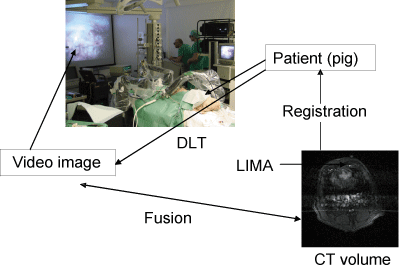|
|||
|
 |
| The Direct Linear Transformation (DLT) is used to map physical space into video image space. By knowing the DLT and the registration between the CT image and physical space, we can fuse the CT and video images. |
Volume registration is a new area of research in medical processing and visulalisation. Registration of multimodal images makes it possible to combine different types of structural and functional information for diagnosis and surgical planning. Registration of images acquired with the same modality at different times or under different conditions allows the control of disease progression or regression. Registration of preoperative images with the physical space occupied by the patient during surgery is a fundamental step in image-guided heart surgery. It allows the fusion of the segmented LIMA from CT volume with endoscopic video images, thus enhancing the surgeon's field of view and the visualisation of the surgical anatomy.
Our approach is an extrinsic registration method, which is based on the implementation of spherical markers on the skin of the patient. A rigid-body transformation modelled as a rotation matrix and translation vector is considered. The registration approach is achieved in four steps:
- localisation of markers in CT images. A global thresholding method is applied to the CT images which produces binary images. The two morphological operations, erosion and dilatation, are applied to the binary images to remove small details and to fill whole appeared on the markers.
- localisation of markers in patient space. A stereoscopic method is used to compute the marker centroids in patient space
- correspondence between markers on image and physical spaces. The correspondence is achieved by using a heuristic measure of point pair affinity
- computation of the mapping transformation. The rotation matrix and the translation vector are computed by using a least squares method.
The method has been tested on synthesised data, and we hope to apply it to real data and exploit the results obtained to fuse the segmented LIMA from the CT volume into video images.
Mohammed El Ansari currently holds an ERCIM fellowship at NTNU.
Please contact:
Mohammed El Ansari, NTNU
E-mail: melansari@yahoo.com


